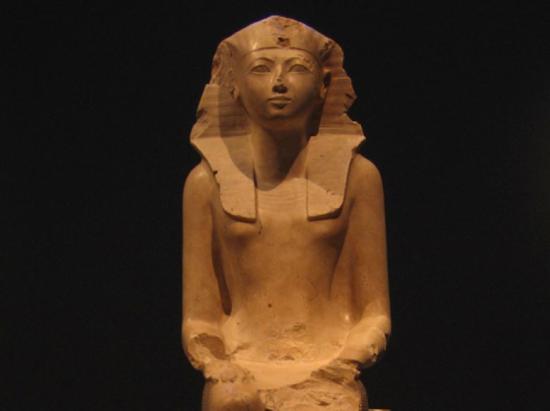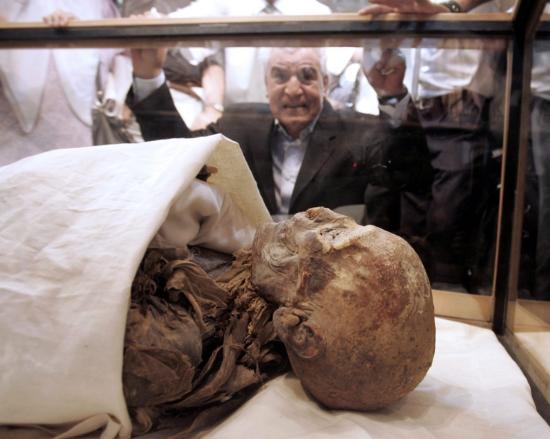Take note, Hillary: Pharaoh Hatshepsut was a visionary ruler who hid her sex behind false beards, but whose successors successfully expunged her memory – until an archaeologist came along.
Nettanel Slyomovics

Statue of Pharaoh Hatshepsut: She has the torso of a woman but the clothing of a man. Statue found near Hatshepsut's funerary temple at Deir el-Bahri, Thebes. At the Metropolitan Museum of Art. Photo by Postdl, Wikimedia Commons
Is America ready for a female president? To some, it sounds absurd that the question of a woman's competence to hold power should even arise in the enlightened 21st century. But to be truthful, variations of the question have been raised throughout history and still do every time a woman comes to a significant position of power.
Here's another question. If Hillary Clinton wins – might she find herself stricken from the record, like the very first (known) female ruler in the world?
In fact, the great female pharaoh Hatshepsut was not supposed to be remembered at all. Her legacy was deliberately eradicated and her memory suppressed for 3,400 years. It was only in 1903, when the English archeologist Howard Carter discovered a small tomb in the Valley of Kings with two unidentified female mummies, and realized to his astonishment what he had apparently found, that history needed rewriting – again.

Hatshepsut's mortuary temple at Deir el-Bahri. Photo: Steve Cameron, Wikimedia Commons
Living in the 15th century BCE, Hatshepsut was the granddaughter of the first rulers of what would be later known as The Golden Empire, which arose roughly a thousand years after the construction of the great pyramids.
Hatshepsut, 1508–1458 BC, came to the Egyptian throne in 1478 BCE, well after the Egypt's split into two by the Hyksos, who conquered the eastern Nile delta in around 1650 BCE, and ended the 13th Dynasty of Egypt.
But a new brand of pharaohs, warriors from Thebes, expelled the occupying Hyksos, reunified the lands along the Nile and began a protracted process of territorial expansion.
Thus, Hatshepsut came to power at a delicate time. Egypt was reinventing itself, and the future while about it: For the first time an empire, the kingdom itself was an innovative force in art and architecture, politics and religion. This legacy would inspire future empires from Rome to Napoleonic France and even the United States.
Hatshepsut's rise to power in and of itself is believed to have precedent in previousEgyptian dynasties, which featured female co-regents, when the new, male pharaoh was too young to competently rule alone. And indeed that is how Hatshepsut's rise to power began as well. But what she did with it was something the world had never seen.
Supplanting the child pharaoh
After the death of her husband and half-brother, Thutmose II, Hatshepsut became co-regent with her stepson and nephew, the child Thutmose III. But unlike previous female co-regents, who governed as queens in the name of a child pharaoh, Hatshepsut dared to claim the official title of pharaoh-king.
Unlike her female predecessors, she had both title and power, and did not let go of either when the child came of age. Instead, she would rule for over two decades, appointing Thutmose III to head the army until her death.
Very much aware that there was no precedent of female rule, Hatshepsut was very active in cementing her authority in the male-dominant culture. Among other things, she went to great lengths to emphasize her divine status as pharaoh: Her monuments to herself served as reminder that she was a god, and no less important, the daughter of the previous male pharaoh.
But this was not enough to grant legitimacy to a female king, as we can gather from some (if not all) of her depictions in statues and carvings: In them, Hatshepsut was portrayed just like all other male Egyptian rulers, with the same style of clothing - and a false beard.

Statue of Pharaoh Hatshepsut, shown with a beard. Photo: Wikimedia Commons
Unwomanly, and expunged
As a ruler, Hatshepsut is known for guiding Egypt through delicate and tumultuous times of change, shaping the land into what would become classical Egypt. The new kingdom had been formed, and began to expand by force, well before her , she was suspicious of the army under Thutmose III and had different ideas.
Instead of expanding Egyptian conquest, she dedicated her time to successfully maintaining peace and prosperity through construction and commerce.
One known example of her policy did involve the army, but the purpose was utterly non-military. She established ties with the Land of Punt, modern-day Eritrea, and sent the military to launch trade in gold, ivory and frankincense. This trade left the world with the oldest known bottle of perfume, bearing Hatshepsut's name and the title "king."
Not only was this a milestone in international trading, , bringing exotic products north: it was an effective political move. The commercial relationship brought fortune and work to Egypt, and it also successfully preoccupied and enriched the military.
After her death, her achievements remained - but not on record. All mentions of her name on monuments, records and in the list of kings were destroyed or erased.

The mummy believed by many to be Hatshepsut. Photo: Reuters
While the true reason cannot be known, archeologist Joyce Tyldesley postulates a simple reason in her book "Hatshepsut: The Female Pharaoh": she was a woman who overstepped her boundaries.
It is unclear if the responsibility for the attempt to expunge Hatshepsut from history rests on her stepson, Thutmose III, who did finally rise to the throne after her, and is considered the greatest warrior king in Egyptian history. Some scholars think it was one of his successors.
Either way, it is clear that once classical Egypt took form, there was no room for even the memory of a woman king. The mummies found in 1903 were in a small tomb believed to be that of Hatshepsut's wet-nurse, Sitre In, and the only reason to suspect that one had been royal was the positioning of the right arm over the woman's chest, archaeologists said.
Yet Hatshepsut's legacy endured, even when she herself had been forgotten.
Some archeologists had already credited to an unknown pharaoh the time of her reign with restoring Egypt's architectural glory, even before her specific existence was rediscovered. And her affection for obelisks revived that trend in her own country, paving the way for their rise in prominence in Western culture - including the Washington Monument, which towers over the White House. For that, Americans can thank Hatshepsut, the female pharaoh who was almost lost in time.